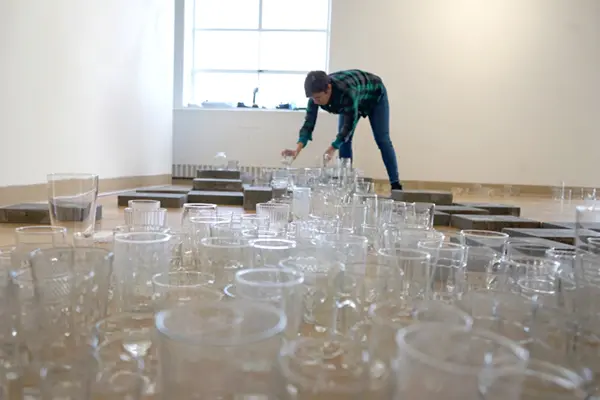Collaborative Exhibit’s Connects Art and Ecosystems
 Image by Ed Brennen
Image by Ed Brennen
01/29/2020
By David Perry
Artist Evelyn Rydz is in Mahoney Gallery on South Campus carefully working about 500 drinking glasses into the shape of the Merrimack River. She arranges them to resemble its vast mouth, its turns and some long stretches now used for recreation.
Rydz’ installation is part of “Local Ecologies,” an exhibition dropping anchor at UML through March 6. It has already docked at galleries at UMass Boston and UMass Dartmouth. A collaborative effort between the three UMass campuses, the traveling exhibition includes newly commissioned works and public programming; its goal is to spark discussions, using location-based art that responds to the region’s environmental and ecological issues.
The exhibit brings together artists, scientists, historians and community members who are engaged with the coastal and river ecosystems and the region’s history.
“We are the last stop,” says Kirsten Swenson, a UML associate professor and art history coordinator who is one of the exhibit organizers. “What is cool about this three-campus exhibition is that each campus is unique in terms of the features of the landscapes. At UMass Lowell, we have the Merrimack River. The exhibit is designed to relate the landscapes to the ecological history and cultural significance of each place.”
Local Ecologies centers around the work of eight artists, including Rydz, but it is also an exhibit designed to make viewers take a deeper look at the natural world around them – especially the Merrimack River. It melds art, science and history into a show that works on multiple levels, notes Swenson.
“It explores a sense of ecology for the natural, cultural and economic aspects of each place,” she says. “A lot of the exhibit is research-based, so vision alone is not necessarily the point.”
“More than half a million people rely on the Merrimack River for their drinking water,” notes Rydz, taking a break from glass placement. “There are chemicals that challenge the water, and when there’s a heavy rain, raw sewage can overwhelm treatment plants and enter the river.”
Another of the exhibit’s artists is Andrew Yang, associate professor of liberal arts at the School of the Art Institute of Chicago, whose work includes installation art and collage. Yang’s contributions include two giant snake-shaped banners made of waste plastics; one of each is suspended in the O’Leary and Lydon libraries.
They are “a metaphor for our troubled relationship with plastics,” he says in a description of his work.
On Jan. 30, Rydz conducted a workshop in Swenson’s Contemporary Art History class, including panels of pH paper with Merrimack River water.
On Feb. 25, Rydz returns for a 3 p.m. workshop open to the campus community that will be held in the Mahoney Gallery. There will be more pH paper painting with river water, as well as a 4 p.m. panel discussion with Asst. Prof. Misha Rabinovich and Asst. Prof. Caitlin Foley of Art & Design, Assoc. Teaching Prof. Lori Weeden of the Kennedy College of Sciences and John Macone of the Merrimack River Watershed Council. Following the discussion, an opening reception in the gallery will begin at 5:30 p.m.
But on this recent day before the exhibit opened, Rydz arranges the glasses, all purchased from New Hampshire and Massachusetts thrift shops within a few miles of the Merrimack River. The glasses were designed to hold everything from fruit cocktails to highballs. Some of the glasses very likely held drinking water from the Merrimack. Old, new, tall and squat, the glasses on the floor represent the water of the river that once gave Lowell its lifeblood.
The river, like glass, is fragile, notes Rydz, and it is far from alone: “Some of the problems we discuss speak to things happening in Lowell. But they also occur all over.”
